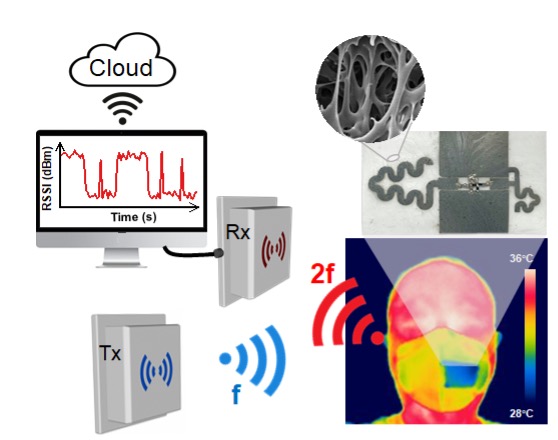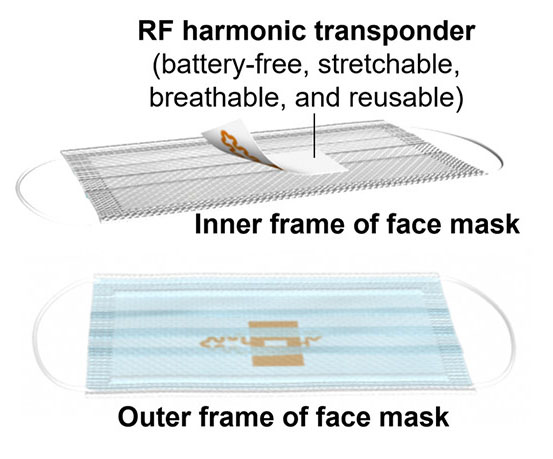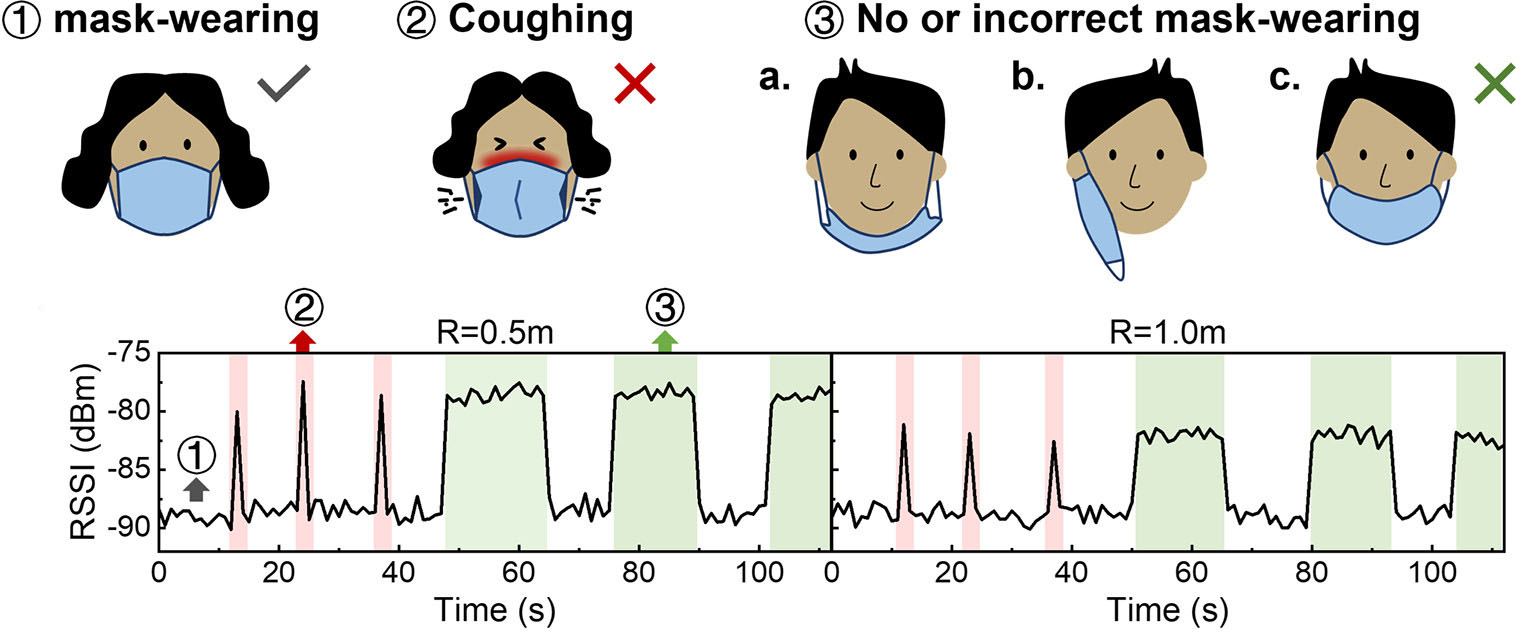| Mar 21, 2022 | |
High-comfort smart face mask checks for proper fit and monitors coughs |
|
| (Nanowerk Spotlight) The increased focus on face masks over the past 2 years due to the COVID-19 pandemic has led to a flurry of research not only on how to make these masks more effective and comfortable for the wearer but also on how to provide them with additional functionality. | |
| Earlier this year, for instance, researchers reported a 'smart' FFP2 face mask that sends a mobile alert when CO2 limits inside the mask are exceeded. Also check our recent Nanowerk Spotlight on the use of nanomaterials in face masks and our global database on commercial nanotech face masks. | |
| "In addition to the significance of fighting the pandemic, there has been a growing trend of developing smart masks and wearables for their potential in health monitoring and preventive care, personalized behavior modeling, and healthcare Internet-of-things," Pai-Yen Chen, an Associate Professor in the Department of Electrical and Computer Engineering at the University of Illinois at Chicago, tells Nanowerk. "Nevertheless, existing research largely ignores wearing comfort and breathability, which are crucial for user experience and compliance of wearing face masks." | |
| To address this issue, a research team led by professor Chen at the University of Illinois at Chicago and professor Zheng Yan at University of Missouri, have developed a multifunctional wireless smart mask, capable of identifying mask-wearing conditions and monitoring the frequency and pattern of coughing – which is a common symptom of many respiratory diseases. | |
 |
|
| Schematics of the proposed smart face mask. (Image: Prof. Pai-Yen Chen Research Group) | |
| As the team reports in ACS Nano ("A Breathable, Reusable, and Zero-Power Smart Face Mask for Wireless Cough and Mask-Wearing Monitoring"), the novel smart mask is capable of simultaneously monitoring coughs and mask-wearing conditions in a remote and battery-free manner, and most importantly, it provides excellent wearing comfort and breathability. | |
| The mask fabric is embedded with a soft and battery-free radio-frequency (RF) harmonic transponder that enables continuous, real-time wireless monitoring of coughs and mask wearing. | |
| Most current smart face masks employ rigid materials or printed circuit boards (PCBs) attached to nonporous polydimethylsiloxane (PDMS), which is generally bulky, cumbersome, and non-breathable. In contrast, the antennas and circuit of the soft, stretchable and flexible RF transponder are manufactured based on spray-printed silver nanowire (AgNWs)/PEDOT:PSS and a multiscale porous substrate, which is ultrasoft, flexible, stretchable, and, most importantly, passive-cooling and breathable for providing long-term wearing comfort. | |
| This zero-power and lightweight smart face mask can not only alert the user when the face mask is worn improperly, but also monitor the user's cough frequency and pattern to analyze respiratory symptoms. | |
 |
|
| Diagram of the smart face mask formed by an ordinary face mask and a soft harmonic transponder attached to its inner layer. (Reprinted with permission by American Chemical Society) | |
| The RF transponder utilizes the harmonic sensing technique to mitigate unwanted electromagnetic interferences, such as clutters and self-jamming, thus enabling real-time monitoring of coughing and appropriate use of masks even in noisy indoor and rich-scattering environments. | |
| This concept relies on transmitting a radio signal and receiving back its harmonics generated by a harmonic tag (Scientific Reports, "A zero power harmonic transponder sensor for ubiquitous wireless µL liquid-volume monitoring"), which in this work is the compact, soft harmonic transponder. The frequency orthogonality can effectively suppress electromagnetic interferences (EMI) in the system. | |
| In addition, unlike current cough-monitoring approaches such as acoustic and optical sensing, the proposed RF approach does not cause any privacy concerns, while providing comparable or even improved accuracy and reliability. | |
| According to Yan, the material innovation is also significant: "We have used, for the first time, the recently discovered porous polystyrene-block-poly(ethylene-ran-butylene)-block-polystyrene (SEBS) substrate (PNAS, "Multiscale porous elastomer substrates for multifunctional on-skin electronics with passive-cooling capabilities") and AgNWs-embedded poly(3,4-ethylenedioxythiophene):poly(styrene sulfonate) (PEDOT:PSS) conductive polymer in the development of soft RF antennas and radio-frequency circuits. Both the SEBS substrate and the conductive polymers are lightweight, flexible, stretchable, and most importantly, breathable (almost resistance-free air and moisture flow), making this new nanomaterial platform particularly suitable for wearable antenna and electronic applications." | |
| Contributing to the wearing comfort of the new mask, the multiscale porous SEBS substrate possesses passive-cooling capacity, effectively reducing the inside temperature of the mask – an important consideration in hot and humid climates. Furthermore, the porous sensor tag is lightweight, ultrasoft, flexible, stretchable, and breathable. The differential pressure drop across the SEBS substrate is comparable to that of a commercial face mask, which indicates that the SEBS-based transponder tag does not cause any respiratory burden. | |
| However, despite excellent conductivity and biocompatibility of the AgNWs used in the harmonic transponder, they lack stability in air due to oxidation and sulfidation. Besides, a potential risk of breathing in AgNWs has been reported, suggesting that inhaled AgNWs may lead to lung inflammation. | |
| To solve these problems, the researchers choose the highly biocompatible conductive material PEDOT:PSS as the passivation layer to isolate the AgNWs and prevent leakage. | |
| "Our experimental results show that the PEDOT:PSS passivation layer can improve the electrical stability of AgNWs under high-humidity and high-temperature conditions and can avoid the potential risk of breathing in the nanomaterials, making the harmonic transponder sticked on the face mask more durable and safe," Yan points out. | |
 |
|
| Time-series received signal strength indicator signals of the SEBS-AgNWs/PEDOT:PSS-based smart face mask with different wearing positions. (Reprinted with permission by American Chemical Society) | |
| He also notes that, in addition to monitoring coughs and recognizing mask-wearing status, the soft harmonic transponder may find many applications in smart wearables, human-machine interfaces, and Internet-of-things (IoT) devices. | |
| For instance, the harmonic transponder can act as a tattoo-like, wearable motion or gesture sensor to detect the movement of knees, elbows, fingers, and so on, since any movement or bending that alters the resonant frequency of the soft antennas can lead to modulation of harmonic received signal strength indicator (RSSI). Hence, the proposed wireless smart face mask may also be used in clinical practice and telemedicine. | |
| The recorded cough events, including the amplitude and number of peaks in the time-domain data, can be analyzed using intelligent algorithms, such as machine learning and deep learning methods, for recognizing features – e.g., dry cough, productive wet cough or chesty cough – that correspond to different respiratory diseases. | |
| Chen and his team are in the process of applying their nanomaterial platform to develop various kinds of battery-free, wireless, wearable sensors. Currently, for instance, a joint team of University of Illinois at Chicago and the University of Missouri scientists, are developing a zero-power, breathable, comfortable smart bandage, which can monitor the local temperature, humidity level, pH value, and uric acid level around the wound. This smart bandage can be integrated with drug delivery system to monitor and facilitate the wound healing process. | |
| Looking to the future, Chen hopes to develop a generalized material platform for wearable antennas and integrated circuits operating at high frequencies. "We foresee that this will be beneficial for many applications, far beyond smart sensors, however, there are still some technical barriers that need to be overcome," he says. "Due to the relatively high sheet resistance of soft conductive materials (when compared with conventional metal wires), it is still difficult to support complex multi-layered circuit designs based on wearable electronics. We are inventing a new material platform and electrical interconnect technique to address these challenges." | |
| Other authors on the study are Zhilu Ye, Minye Yang, and Liang Zhu at the University of Illinois at Chicago, and Yun Ling, Yadong Xu, and Zheng Yan at University of Missouri. | |
 By
Michael
Berger
– Michael is author of three books by the Royal Society of Chemistry:
Nano-Society: Pushing the Boundaries of Technology,
Nanotechnology: The Future is Tiny, and
Nanoengineering: The Skills and Tools Making Technology Invisible
Copyright ©
Nanowerk LLC
By
Michael
Berger
– Michael is author of three books by the Royal Society of Chemistry:
Nano-Society: Pushing the Boundaries of Technology,
Nanotechnology: The Future is Tiny, and
Nanoengineering: The Skills and Tools Making Technology Invisible
Copyright ©
Nanowerk LLC
|
|
|
Become a Spotlight guest author! Join our large and growing group of guest contributors. Have you just published a scientific paper or have other exciting developments to share with the nanotechnology community? Here is how to publish on nanowerk.com. |
|
